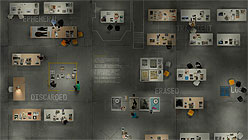Just as history is written by the victors, so is art history written by the extant artworks. And yet, sometimes absence increases influence and unseen, unfinished, unrealized artworks gain legendary status. The Gallery of Lost Art, a year-long online exhibition curated by the Tate explores how such loss silently shapes the course of art history.
The exhibition appears as an overhead view inside a warehouse in which works by over 40 artists are profiled, surrounded by the evidence of their existence. An investigation appears underway; sporadic figures bend over paperwork or type away at computers while spooky ambient music provides the soundtrack. Artworks are classified by their mode of disappearance — attacked, ephemeral, erased, destroyed, missing, rejected, stolen, transient, or unrealized — though many pieces bridge several of these at once. Zooming in on a single case, an array of photographs, documents, video segments, and other visual material comes into focus, along with thoughtful essays by Jennifer Mundy, the exhibition’s curator.

Daniel Buren’s Painting I, one part of the work Painting-Sculpture 1971, installed in the Solomon R. Guggenheim Museum, New York, February 1971.
While many of the pieces and their stories will be well known, The Gallery of Lost Art is a rabbit hole of juicy art world inside information. I was shocked to learn about Daniel Buren’s Painting-Sculpture (Painting I and Painting II), made specifically for the Sixth Guggenheim International in New York. Though cleared with the curator in advance, Painting I caused other artists in the exhibition to feel their work was — literally — overshadowed when the gargantuan striped cloth reached its full length in the museum’s atrium. The piece was removed just prior to the show’s opening without consulting Buren. The Guggenheim refused to reverse its actions even when Buren supplied a petition signed by 15 of the 21 artists in the show. Factions divided, recriminations flew, and in a pithy about-face Dan Flavin, one of the aforementioned 15, even described Buren’s work as “miserable nonsense.”
While Buren’s piece remains in storage to this day, many of the profiled works were lost suddenly and violently. Many were unfortunate victims of authoritarian regimes. All that remains of Otto Dix’s The Trench is a few fuzzy black and white photographs, one of them taken at Reflections on Decadence in Art, the 1933 exhibition organized by the Nazis (along with the 1937 exhibition Degenerate Art) to condemn modernist works they found repellant. Otto Freundlich’s Large Head (The New Man) graced the cover of the Degenerate Art catalogue. Kurt Schwitters’ original Merzbau was destroyed by WWII bombing, as was Wassily Kandinsky’s Composition I.




